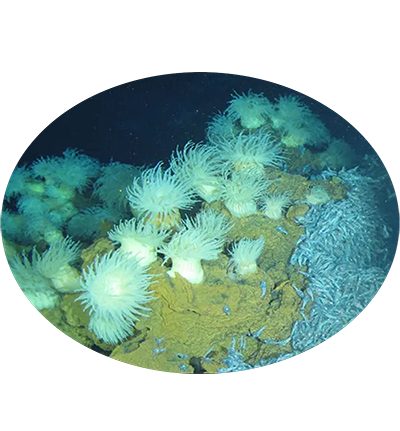The vent sea anemoneAlvinactis idsseensis sp. Nov. is a species in the family Actinoscyphiidae. They can flourish in a variety of deep-sea environments. Most sea anemones thriving in sulfide-rich hydrothermal vent peripheral zone obtain nutrients by eating blind shrimp, rather than relying on chemoautotrophic carbon production.
Animalia Kingdom; Cnidaria (Phylum); Anthozoa (Class); Actiniaria (Order); Actinoscyphiidae (Family); Alvinactis (Genus); Alvinactis idsseensis sp. Nov. (Species)
Alvinactis sp. ZX-2022
| Species | Phylum | Common Name | Ecosystem | Depth | Habitat | NCBI Taxonomy ID |
|---|
| Alvinactis idsseensis sp. Nov. | Cnidaria | Alvinactis sp | Deep sea | 3,279 | Southwest Indian Ocean “Edmond” hydrothermal vent filed in the CIR (69 59′E, 23 87′S) | 2978091 |
| Genome Assembly | Genome Size | Assembly level | Released year | WGS accession | Submitter | BioProject | BUSCO completeness (%) | Scaffold/Contig N50 (kb) | GC content (%) | Repeat Rate (%) | Gene Number |
|---|
| - | 456.58Mb | Chromosome | 2023 | - | Institute of Deep-sea Science and Engineering, Chinese Academy of Sciences | PRJNA909864 | 92.80 | 27,561/1,715 | 38.84 | 63.27 | 31,960 |
| Title | Journal | Pubmed ID |
|---|
| Genetic adaptations of sea anemone to hydrothermal environment | Science Advances | 37862424 |
| Annotation ID | Description | Type | Subtype | GeneRatio | Evolution Type | P-value | Q-value |
|---|
| GO:0016705 | oxidoreductase activity, acting on paired donors, with incorporation or reduction of molecular oxygen | GO | Molecular Function | - | expanded | 1.55E-29 | 2.06E-26 |
| GO:0005506 | iron ion binding | GO | Molecular Function | - | expanded | 1.33E-27 | 1.77E-24 |
| GO:0020037 | heme binding | GO | Molecular Function | - | expanded | 9.81E-20 | 1.30E-16 |
| GO:0004252 | serine-type endopeptidase activity | GO | Molecular Function | - | expanded | 5.15E-19 | 6.82E-16 |
| GO:0055085 | transmembrane transport | GO | Biological Process | - | expanded | 2.66E-16 | 3.53E-13 |
| GO:0006508 | proteolysis | GO | Biological Process | - | expanded | 3.90E-16 | 5.18E-13 |
| GO:0000723 | telomere maintenance | GO | Biological Process | - | expanded | 3.48E-14 | 4.62E-11 |
| GO:0006955 | immune response | GO | Biological Process | - | expanded | 1.66E-13 | 2.21E-10 |
| GO:0030247 | polysaccharide binding | GO | Molecular Function | - | expanded | 1.66E-13 | 2.21E-10 |
| GO:0003678 | DNA helicase activity | GO | Molecular Function | - | expanded | 2.01E-13 | 2.67E-10 |
| GO:0006468 | protein phosphorylation | GO | Biological Process | - | expanded | 7.46E-12 | 9.89E-09 |
| GO:0005044 | scavenger receptor activity | GO | Molecular Function | - | expanded | 1.06E-11 | 1.41E-08 |
| GO:0008378 | galactosyltransferase activity | GO | Molecular Function | - | expanded | 4.15E-11 | 5.50E-08 |
| GO:0022857 | transmembrane transporter activity | GO | Molecular Function | - | expanded | 5.29E-10 | 7.02E-07 |
| GO:0016021 | integral component of membrane | GO | Cellular Component | - | expanded | 1.52E-09 | 2.02E-06 |
| GO:0004672 | protein kinase activity | GO | Molecular Function | - | expanded | 2.98E-09 | 3.95E-06 |
| GO:0005524 | ATP binding | GO | Molecular Function | - | expanded | 7.02E-09 | 9.30E-06 |
| GO:0055114 | oxidation-reduction process | GO | Biological Process | - | expanded | 1.19E-08 | 1.57E-05 |
| GO:0016758 | transferase activity, transferring hexosyl groups | GO | Molecular Function | - | expanded | 2.32E-08 | 3.08E-05 |
| GO:0005515 | protein binding | GO | Molecular Function | - | expanded | 3.52E-07 | 0.000466369 |


